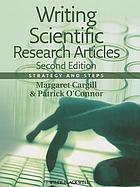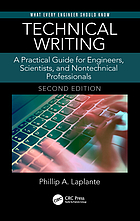Format and Content Basics
 Writing and formatting styles vary from one discipline to the next. Therefore, it is not too convenient to establish excessively rigid formatting rules for all TDPs. However, there are certain general aspects that are common to the majority of TDPs. In this section, we focus on those.
Writing and formatting styles vary from one discipline to the next. Therefore, it is not too convenient to establish excessively rigid formatting rules for all TDPs. However, there are certain general aspects that are common to the majority of TDPs. In this section, we focus on those.
We hope that the content included here gives you a pretty clear idea about how your TDP should be formatted. Always consult with your advisor so you are aware of any format requirements that specifically apply to TDPs in your field.
Thesis and Dissertation Templates
Below are two templates that you can use for your thesis or dissertation, one for Word and one for Overleaf. They will be tremendously helpful as you write and format your document. These templates were created by the Graduate Writing Facilitators (GWF) based on the recommendations provided by the Office of Graduate Studies for formatting theses and dissertations. We review and update the templates periodically.
- Thesis and Dissertation Template for Word - Click on the link and select the "Original file" option to download as a Word document. You can also view and download the template in PDF format.
- Thesis and Dissertation Template for Overleaf (LaTeX)
For a demonstration on how to use these thesis templates for Word and Overleaf, access this recording of the GWF clinic titled Overleaf vs. MS Word: Templates 101
Other highly recommended resources:
- Guías para la preparación de propuestas, tesis, proyectos y disertaciones (Guides for the Preparation of Proposals, Theses, Projects, and Dissertations)
- Mapping Your Thesis: From Research Idea to Manageable Thesis Project (GWF clinic slides)
- Plantilla para la preparación de tesis en Microsoft Word (Thesis Preparation Template in Microsoft Word) - Click on the link and select the template from the right-hand column, which is titled "Recursos y documentos" (Resources and Documents).
Books on Academic Writing Available in the General Library

T11 .S35 2012
Available at the GRIC and in the Circulation Collection

PE1429 .Z5 2006
Available at the GRIC and in the Circulation Collection

PE1408 .S772 2018
Available at the GRIC

Z471 .B45 2009
Available at the GRIC

Q223 .S2354 2009
Available at the GRIC and in the Circulation Collection

T11 .S529 2013
Available at the GRIC

T11 .C327 2013
Available in the Circulation Collection

T11 .L27 2012
Available in the Circulation Collection
Main Sections of TDPs
Here we take a look at the main sections that should be included in a TDP. We discuss the purpose of each section and the information it must contain. Keep in mind that more specific or nuanced aspects can vary from one discipline to the next. Therefore, if you have questions regarding the content of a section in your TDP, be sure to consult with your advisor, as this person will be able to give you an answer that is in accordance with common practices in your field.
The title page of the final electronic version of your TDP must include the following elements:
- Title
- Your name
- Year it was submitted
- Names and academic degrees of the following people:
- The members of your defense committee
- Your department head
- In the case of doctoral dissertations, the director of the Office of Graduate Studies
Below we present an example of a TDP title page.
Your TDP must include a section titled "Abstract". Here, you must summarize the topic and objectives of your study, the methods that were applied, and the obtained results. You must also include a section titled "Resúmen", which is the Spanish version of the abstract.
The slide presentation Mapping Your Thesis: From Research Idea to Manageable Thesis Project, created by the Graduate Writing Facilitators, provides excellent advice on how to write a strong abstract. This presentation establishes the following ABC of elements that characterize effective abstracts:
Accurate: Reads as one well-developed, coherent paragraph covering all the elements of your thesis: introduction, purpose, methods, results, conclusions.
Brief: Contains concise and precise language and stands alone as a unit of information. Does not include: superfluous adjectives, verbosity or redundancy, personal narrative, opinion or commentary, figures, tables or graphs.
Clear: Generally uses the third person and active voice. Does not contain jargon, colloquialisms, literature citations, contractions, acronyms or abbreviations.
The following are links to online resources that will help you draft a good abstract:
- How to Write an Abstract (Chemistry Community - Nature Research)
- Writing Report Abstracts (Purdue Online Writing Lab)
- Writing Scientific Abstracts Presentation (PowerPoint Presentation by Purdue Online Writing Lab)
- Writing an Abstract (The Writing Center - George Mason University)
- Make a Great First Impression: 6 Tips for Writing a Strong Abstract (AJE Scholar)
The section titled "Introduction" (which can also be called "Justification" or "Motivation") will be the opening chapter of your TDP. This section gives the reader a detailed description of the following:
- The topic of your study
- The objectives of the research project
- The hypothesis or research questions
- Any theoretical frameworks that your study is based on
- How the study contributes to the body of knowledge in your field
- How the study was conducted
- The scope of the study and the limitations it may have
A good introduction gives the reader a full understanding of the reasons behind the study. This section is tied to the literature review, given that when you describe why your study is important and how it constitutes a contribution to your discipline, you should make reference to the knowledge gaps that exist in your field.
When you write your introduction, try to convey the passion you feel for your research topic. Do your best to captivate the interest of your readers.
The literature review you include in your TDP must show that you have knowledge of the studies that have been published previously on your topic. It is important for you to be aware of dominant perspectives and research trends in your field, as well as theoretical frameworks that may be related to your work. This will reassure you that your study is in fact original and represents a true contribution to your discipline.
It is helpful to think about the body of academic literature as an ongoing conversation. Your research project represents your entry into this conversation. In order for you to contribute to the discussion, it is important that you know what has been said before and what specific topics are currently attracting the most attention. Reviewing the literature prepares you in this regard.
Use this section to communicate to your readers that you have researched the body of literature related to your topic and that you are familiarized with it. Think of the literature review as a process that will help you refine your focus and will sharpen your ability to speak about your topic with greater confidence and fluidity. This will help you tremendously when the time arrives to defend your TDP.
Below are some resources that will help you with your literature review:
- Literature Review Clinic (Graduate Writing Facilitators)
- The Writing Center, University of North Carolina at Chapel Hill
- Go to the "Tips & Tools" tab
- Click on the "Literature Reviews" link
- Literature Reviews: An Overview for Graduate Students (North Carolina State University Libraries)
- How to Write a Literature Review (Wordvice Editing Service)
To sustain the validity of your TDP, it is crucial that you clearly detail the methodology that you followed to conduct the study. In this section of your work, you must accurately describe your data collection and analysis processes. Be thorough as you recount how you carried out your research project. Try to provide sufficient information for someone else to be able to replicate your study if they wished to do so.
Given that each study is different, the specific content of the methodology section will vary from one work to the next. Nevertheless, here we provide a non exhaustive list of elements you may want to include:
- What was the research subject selection criteria, and why were those criteria established?
- Explanation of the design and validation of data collection instruments (such as surveys or interviews)
- Information about calibration of laboratory instruments
- Information about the date, time, or place of observation or data collection, if relevant
- Name and version of software programs used
- Any computer code created specifically for the study
- Explanation of coding applied to interview responses
- Formulas used to analyze data
It is also important for you to be aware of the research methodologies most commonly used in your discipline. Quantitative methods are predominant in some fields, while qualitative methods are more usual in others. Additionally, studies in some fields may use mixed methods, which combine quantitative and qualitative approaches.
It is crucial that you record your research process as you are carrying it out. Document everything, and make notes clearly detailing the application of your methodology. Failing to record information can bring you difficulties later. If at the end of your project, you cannot show what process you followed to obtain the results you are reporting, the validity of your investigation may be challenged.
The General Library has plenty of resources on research methodology. To see some of them, click here.
In this section, you must provide a report of the results obtained in your study. It is important not to go into discussion or interpretation of the results in this section. The discussion of the results will be included in a separate section. Nevertheless, try to be as detailed and comprehensive as possible when describing your results.
Your results section must tie in well with the other sections of your TDP. The results you report must reflect your objectives, hypothesis, and/or research questions. Likewise, you must inform the reader about what was specifically obtained with each data collection method you used. In addition to reporting data collection results, you must report the results of your analysis.
When drafting this section, make sure that you address all aspects of your study and that you establish a solid groundwork for your conclusions. Take care not to leave loose ends. Include any tables or figures that will help your readers understand your results better.
Finally, remember that it is very important to store your research data adequately, even after you have concluded your study. If someone were to question your results or your conclusions, it will be convenient for you to have your data handy, so you can back up whatever you reported. For more information on proper data storage and data management best practices, refer to our research data management online guide.
In this section, you must present your final interpretations and analysis of your study. These are some guiding questions you can use:
- In summary, what did the study demonstrate?
- Were the research questions answered?
- Are the obtained results what you anticipated?
- What can be improved in terms of the design of the study?
- What questions were raised by your study which could be addressed by future researchers?
When you present your conclusions, you should make direct reference to your results, given that your arguments should be based on these. Clearly establish the logical connections between your data and your final statements.
Also, discuss the relationship between your findings and conclusions and previous studies conducted on your topic. ¿How do your results compare to these? ¿What similarities and differences exist?
Consider these points as you draft this final section. In your conclusion, you should demonstrate that you have met the main objective of a TDP, which is to make an original and concrete contribution to the body of knowledge of your field.
In your bibliography or references list, you must include bibliographic references to the sources you used in your TDP. There are some differences between a bibliography and a references list. In a bibliography, you can include sources that you used to obtain background information or that influenced your work, but that you did not cite in your document. In a references list, you should only include sources which you cited in your study.
Some disciplines require you to include a bibliography, while others ask for a references list. Check with your advisor to make sure you know what applies to you.
In any case, your bibliography or references list must contain full, correctly formatted bibliographic references. The formatting must be consistent and in accordance with the rules of the style manual or author guide you are using. Each entry must provide enough information for the reader to be able to accurately identify the source and access it if possible.
Citation Management Software, Style Manuals, and Author Guides
In order to save time and effort, it is recommendable to use a citation management program for this section of your TDP. With citation management software, you can automatically generate your bibliography or references list. Two citation management programs that are widely used are Zotero and Mendeley. These programs are free and easy to learn.
We also recommend that you check what style manual or author guide is used in your discipline for formatting academic documents. These manuals and guides have rules on how to present your references.
The Citation section of this guide contains information on Zotero and Mendeley. It also includes information on style manuals and author guides used in a variety of disciplines, as well as links to related resources.
Some General Format Rules
Specific format rules vary from one discipline to the next. For this reason, you should discuss the rules applicable to your TDP with your advisor. If you have to format your TDP in accordance with a style manual or an author guide, make sure you become familiar with it. Also, make sure you keep a consistent format and structure throughout your TDP that allows you to communicate your ideas as clearly as possible.
Here we present some general formatting concepts for TDPs. You can find more thorough suggestions in the document Guías para la preparación de propuestas, tesis, proyectos y disertaciones (Guides for the Preparation of Proposals, Theses, Projects, and Dissertations), specifically in the section titled "Presentación del manuscrito" (Manuscript Presentation", located on page five. This document is available on the webpage titled "Redacción de la tesis, informe de proyecto o disertación" (Drafting of Your Thesis, Project Report, or Dissertation"), published by the Office of Graduate Studies.
Font
Recommended fonts are Times New Roman or Arial, 11-point or 12-point. These fonts are recommended because they are very readable.
Line Spacing
Generally, text in the body of TDPs should be one-and-a-half or double spaced. Check the style manual or author guide used in your discipline. Also consult your advisor.
Margins
Use one-inch margins on all four sides.
Page Numbers
On the preliminary pages of your TDP, use roman numerals. Place them at the bottom of the page, centered. The title page is the first page, but it is not numbered. Therefore, the first page number that will appear in your TDP is the roman numeral "ii". If you are unsure about which are the preliminary pages of your TDP, check the left-hand column on this page.
After the preliminary pages, use Arabic numbers. These should go on the upper right-hand corner. If you want, on the first page of each main section, you can place the Arabic number on the bottom of the page, centered.
Style Manuals and Author Guides
If you need information about style manuals, author guides, or related resources used in your discipline, check the Citation section of this guide.
TDP Format From a Bird's Eye View

